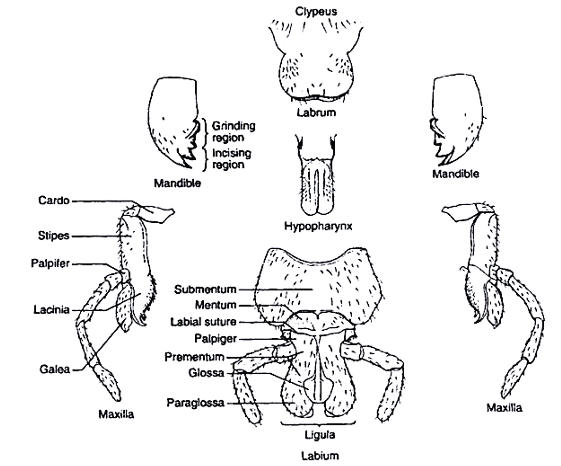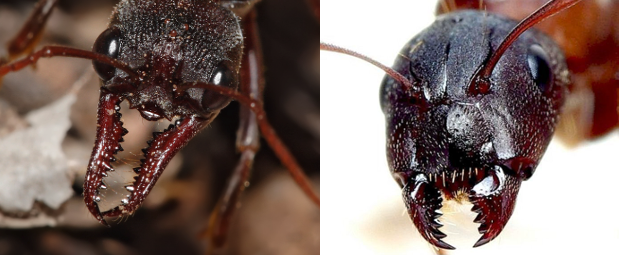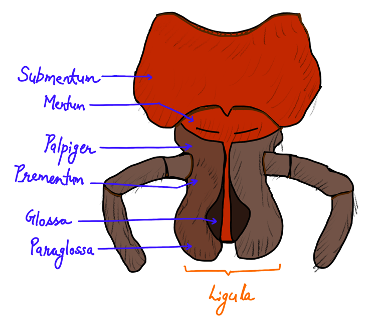🦞 Biting & Chewing
Types of Mouth, Mandible, Maxillae, Labrum, Labrum – Epipharynx, Hypopharynx, Examples
The mouth part which is not present in pair?
Mouth Parts and its types
- Important for insect identification.
- Provides information on feeding habits and types of damage.
- Insects have mouthparts that may vary greatly across insect species, as they are adapted to particular modes of feeding.
- The earliest insects had chewing mouthparts.
- Most specialisation of mouthparts are for piercing and sucking, and this mode of feeding has evolved a number of times independently.
- They are mainly of two types viz.,
- Mandibulate (feeding mainly on solid food)
- Haustellate (feeding mainly on liquid food)
👉🏻 The mouth parts of insects can be basically grouped in to following types based on the type of food and method of feeding.

Biting & Chewing or Biting & Cutting Type
- This type is considered as primitive type of mouth part (Typical type) and found in Orthoptera, Isoptera and Coleoptera, larvae of Lepidoptera and Neuroptera etc.
- Typical mouthpart of an insect consists of the following parts:

Mandible

- There are one pair of mandibles. (2 mandibles)
- That’s why these mouth parts are known as mandibulate type of mouth parts.
- They are the first pair of jaws. They also called as primary jaws or true jaws.
- These are the paired, unsegmented, strongest, and sclerotized structures called jaws.
- They are toothed on their inner border. There are two types of teeth. Distal are sharply pointed and are called incisor or cutting teeth that help in the process of cutting the food material. And proximal teeth are called molar or grinding teeth that helps in crushing the food material.
Maxillae

- There are one pair of Maxillae. (2 Maxilla)
- More complicated than mandibles.
- They are called as secondary jaws or accessory jaws. They act as auxiliary jaws and assist in mastication of food.
- At proximal end the first sclerite cardo joins the maxilla to head.
- The second sclerite is called stipes which articulates with cardo.
- Stipes carries a lateral sclerite called palpifer which bears a five segmented antenna like maxillary palp.
- On the distal end of the stipes, there are two lobes. The outer lobe is called galea and inner lobe is lacinia which is toothed.
- Maxillae direct the food into the mouth. They hold the food in place when the mandibles are in action.
- Sense organs connected with the perception of touch, smell (olfactory) and taste (gustatory) are abundantly found in maxillary palpi.
Labrum
- It acts like upper lip. As it covers the mouth cavity from above. It helps to pull the food into the mouth. - It is a flap like, bilobed and attached to clypeus by an articular membrane. It is movable.
- It forms the roof of the pre oral food cavity. It holds the food in position so that mandibles can act on it.
Labrum – Epipharynx
- On its inner surface, labrum consists of lobe like structure called
labrum – epipharynx. - It is an organ of taste.
- It is well developed in Hymenoptera.
Labium

- It acts like lower lip. As it bounds the mouth cavity from below or behind. It forms the base of the preoral cavity.
- It is a composite structure formed by the fusion of two primitive segmented appendages.
- The labium has broad basal portion which is divided into regions called the submentum (large basal sclerite), which is the proximal part, the mentum in the middle, and the prementum, which is the distal section, and furthest anterior.
- On the lateral side of the prementum there are two small lateral sclerites called palpiger bearing three segmented labial palpi.
- Distally prementum bears two pairs of lobes. The other pair of lobes is called para glossae and inner pair of lobes, glossae. Both pairs when fused are called ligula.
- The median pair is glossae and outer paraglossae together called ligula that function mainly as gustatory sense organs.
Hypopharynx
- It works like Tongue. It mixes the crushed and cut food material.
- It is a tongue like structure situated between labrum and labium and ducts of salivary glands open on or near its base.
Examples
- Found in Grasshoppers & Locust (Orthoptera), Termites (Isoptera), Beetles & Weevils (Coleopteran).
- Even in some insect species the mouth parts are different in different phases of life.
- Lepidopteran Larvae have biting and chewing type of mouth parts. Whereas adult Lepidoptera have sucking type of mouthparts.
- This is because they are adapted as per the available food type.
References
- Insecta - Introduction: K.N. Ragumoorithi, V. Balasurbramani & N. Natarajan
- A General Textbook of Entomology (9th edition, 1960) – A.D. Imms (Revised by Professor O.W. Richards and R.G. Davies). Butler & Tanner Ltd., Frome and London.
- The Insects- Structure and Function (4th Edition, 1998) – R.F. Chapman. Cambridge University Press
- Wikipedia
The mouth part which is not present in pair?
Mouth Parts and its types
- Important for insect identification.
- Provides information on feeding habits and types of damage.
- Insects have mouthparts that may vary greatly across insect species, as they are adapted to particular modes of feeding.
- The earliest insects had chewing mouthparts.
- Most specialisation of mouthparts are for piercing and sucking, and this mode of feeding has evolved a number of times independently.
- They are mainly of two types viz.,
- Mandibulate (feeding mainly on solid food)
- Haustellate (feeding mainly on liquid food)
👉🏻 The mouth parts of insects can be basically grouped in to following types based on the type of food and method of feeding.

Biting & Chewing or Biting & Cutting Type
- This type is …
Become Successful With AgriDots
Learn the essential skills for getting a seat in the Exam with
🦄 You are a pro member!
Only use this page if purchasing a gift or enterprise account
Plan
Rs
- Unlimited access to PRO courses
- Quizzes with hand-picked meme prizes
- Invite to private Discord chat
- Free Sticker emailed
Lifetime
Rs
1,499
once
- All PRO-tier benefits
- Single payment, lifetime access
- 4,200 bonus xp points
- Next Level
T-shirt shipped worldwide

Yo! You just found a 20% discount using 👉 EASTEREGG

High-quality fitted cotton shirt produced by Next Level Apparel